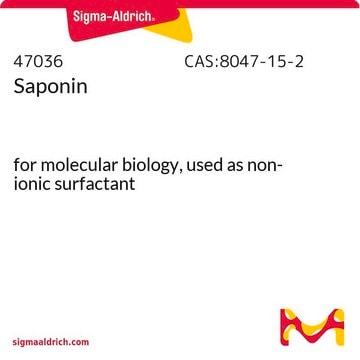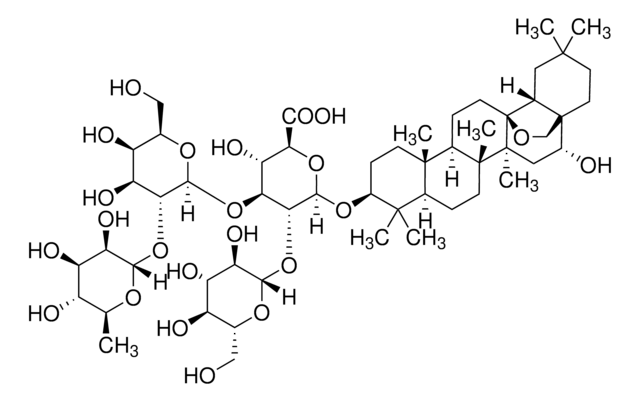S4521
Saponin from Quillaja sp.
Sapogenin content 20-35 %
Sign Into View Organizational & Contract Pricing
All Photos(2)
About This Item
Recommended Products
description
non-ionic
composition
Sapogenin content, 20-35%
technique(s)
HPLC: suitable
protein quantification: suitable
sulfated ash
≤10%
General description
Saponins are steroid or triterpenoid glycosides. They are biosurfactants that have several uses in the food and cosmetic industry.
Application
Saponin from Quillaja bark has been used:
- to stain fertilized oocytes
- in the analysis of intracellular cytokine production
- to permeabilize dendritic cells
Biochem/physiol Actions
Saponins solubilize the low density lipoprotein (LDL) fraction of cholesterol in micelles, thus lowering their concentration. Saponin from Quillaja bark is used as a flavoring agent in food and beverages. This saponin has been shown to enhance immune-cell proliferation in vitro.
Potent hemolytic when injected i.v.; surfactant that enhances penetration of proteins and other macromolecules through cell membranes; it also has been used as an adjuvant for vaccines.
Preparation Note
Purified to remove low molecular weight contaminants
Signal Word
Warning
Hazard Statements
Precautionary Statements
Hazard Classifications
Eye Irrit. 2 - STOT SE 3
Target Organs
Respiratory system
Storage Class Code
11 - Combustible Solids
WGK
WGK 2
Flash Point(F)
Not applicable
Flash Point(C)
Not applicable
Personal Protective Equipment
dust mask type N95 (US), Eyeshields, Gloves
Certificates of Analysis (COA)
Search for Certificates of Analysis (COA) by entering the products Lot/Batch Number. Lot and Batch Numbers can be found on a product’s label following the words ‘Lot’ or ‘Batch’.
Already Own This Product?
Find documentation for the products that you have recently purchased in the Document Library.
Customers Also Viewed
R Martin-Ibañez et al.
Human reproduction (Oxford, England), 23(12), 2744-2754 (2008-08-22)
Human embryonic stem cells (hESCs) have potential use in clinical therapy and regenerative medicine. One of the major challenges regarding the application of these cells is the development of an efficient cryopreservation protocol, since current methods, which include slow-freezing-rapid thawing
Dynamic chromatin modifications characterise the first cell cycle in mouse embryos.
Santos F
Developmental Biology, 280(1), 225-236 (2005)
Isolation of myeloid and plasmacytoid dendritic cells from human bronchoalveolar lavage fluid.
Tsoumakidou M
Immunology and Cell Biology, 84(3), 267-273 (2006)
Yvonne Lange et al.
Biochemistry, 48(36), 8505-8515 (2009-08-07)
A few membrane-intercalating amphipaths have been observed to stimulate the interaction of cholesterol with cholesterol oxidase, saponin and cyclodextrin, presumably by displacing cholesterol laterally from its phospholipid complexes. We now report that this effect, referred to as cholesterol activation, occurs
Subset-dependent modulation of dendritic cell activity by circovirus type 2.
Vincent IE
Immunology, 115(3), 388-398 (2005)
Our team of scientists has experience in all areas of research including Life Science, Material Science, Chemical Synthesis, Chromatography, Analytical and many others.
Contact Technical Service














